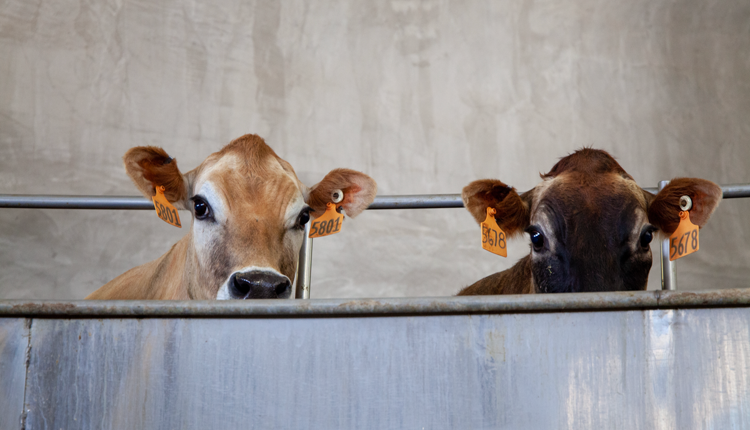
Fertilization rates range from 55% to 88% in high-producing dairy cows, resulting in calving rates of 30% or less following a single A.I. Pregnancy loss remains a major factor inhibiting reproductive performance in dairy cattle, with the bulk of losses occurring before 42 days of gestation.

In an attempt to control this issue, numerous studies have focused on raising progesterone concentrations in early pregnancy. The corpus luteum (CL) forms following ovulation and produces progesterone, the hormone necessary for maintenance of pregnancy in cattle.
The use of gonadotropin releasing hormone (GnRH) or human chorionic gonadotropin (hCG) to induce ovulation and an accessory CL on Days 5 to 7 of the estrous cycle reduced pregnancy loss in embryo transfer recipients. However, uneven fertility results have been reported from research that elevated progesterone concentrations after A.I. in lactating dairy cows.
Following fertilization in the oviduct, the embryo enters the uterus approximately five days after ovulation. Early development of the placenta and attachment occur nearly 21 days after ovulation. In ruminants, embryonic and uterine cells fuse to form bi- or multinucleated giant cells, which produce pregnancy-associated glycoproteins (PAG). The specific role of PAG is unknown; however, PAG have been used as a marker of early placentation and attachment, and therefore, pregnancy.
PAG and progesterone
University of Wisconsin-Madison researchers recently investigated the effect of higher progesterone on embryonic attachment as measured by daily PAG concentrations. The same researchers also asked the question, “Is pregnancy loss initiated by embryonic death or luteal regression?”
Lactating dairy cows received either double-ovsynch or ovsynch (for resynchronization), with the day of the final GnRH considered Day 0. All animals received timed A.I. approximately 16 hours after the final GnRH. Cows were randomly allocated to receive either saline (control) or hCG on Days 7 and 13 after GnRH.
Pregnancy was diagnosed using ultrasonography, including visualization of a heartbeat on Day 33. A 10% rise in PAG concentration after Day 17 was used as a measure of embryo attachment. Pregnancy loss was determined by a 10% decline in PAG concentration or ultrasonography of an embryo between Days 28 and 32 followed by the absence of a heartbeat on Day 33.
In pregnant cows, progesterone concentrations were greater in the hCG-treated group from Day 8 to 61. Treatment with hCG during the luteal phase of the estrous cycle promotes ovulation of a dominant follicle within 24 to 32 hours, leading to greater progesterone due to the development of an accessory CL. In addition, hCG stimulates progesterone production from the original CL. Treatment with hCG on Day 13 caused higher progesterone concentrations by Day 15, providing evidence the second hCG treatment stimulated progesterone synthesis by the original and accessory CL.
From Day 17 to 33, PAG concentrations were similar between the control and hCG groups regardless of elevated progesterone concentrations. During the second month of gestation (specifically Day 47 and 61), higher progesterone was associated with higher PAG.
Unfortunately, the physiological importance of greater PAG concentrations during the second month of gestation is not known. There was no effect of parity or sire on progesterone or PAG concentrations. Pregnancy per A.I. was not different between the control and hCG-treated groups at either Day 33 or 61.
The first significant jump in PAG in pregnant cows occurred on Day 21 for the control and hCG-treated groups. Consequently, greater concentrations of progesterone were not associated with earlier embryonic attachment.
A 50/50 split
Pregnancy loss between Day 20 and 33 occurred in nearly 25% of cows. To further understand the relationship between progesterone and pregnancy loss, the association of progesterone and PAG concentrations in cows experiencing pregnancy loss before Day 33 was studied further. In 53.3% of cows, luteolysis occurred before any decrease in PAG concentrations, providing evidence that pregnancy loss was initiated by CL regression and the failure to maintain necessary progesterone concentrations for continuation of the pregnancy.
In 46.7% of cows with pregnancy loss between Day 20 and 33, PAG concentrations began to drop before luteolysis, providing evidence of embryo failure rather than maternal failure to maintain adequate progesterone concentrations.
Pregnant cows with luteal regression and a decline in PAG concentrations at the same time were not observed in this study. Therefore, the answer to the question of whether pregnancy loss is initiated by embryonic death or luteal regression is that about 50% of pregnancy loss occurred due to luteal regression and 50% due to embryonic death.
We can couple this information with genomic data describing the unique loci associated with pregnancy loss in primiparous cows and the Colorado State University study in which the odds of pregnancy loss were 5.2 and 2.7 times greater for first-lactation cows that took at least four services to settle than for cows that took one and two to three, respectively (see “Uncovering the mysteries of pregnancy loss,” Hoard’s Dairyman, November 2021, page 683). The pieces of the pregnancy loss puzzle are coming together. Happy A.I. breeding!









